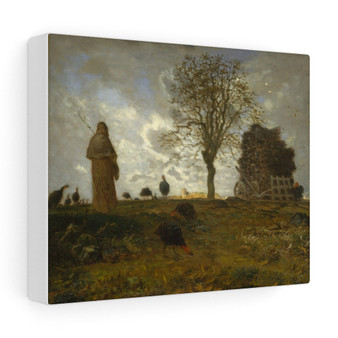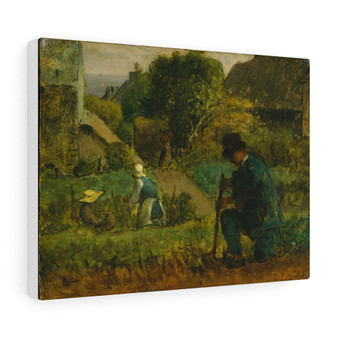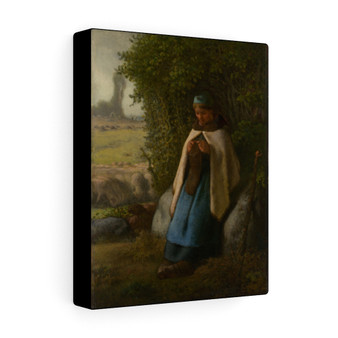Product Description
Haystacks- Autumn, ca. 1874, Jean-François Millet French. Historical artwork in public domain. This picture is from a series depicting the four seasons commissioned in 1868 by the industrialist Frédéric Hartmann. Millet worked on the paintings intermittently for the next seven years. In Autumn, with the harvest finished, the gleaners have departed and the sheep are left to graze. Beyond the haystacks lie the plain of Chailly and the rooftops of Barbizon. The loose, sketchlike finish of this work is characteristic of Millet's late style: patches of the dark lilac-pink ground color are deliberately exposed, and the underdrawing is visible, particularly in the outlines of the haystacks and the sheep. Title: Haystacks: Autumn Artist: Jean-François Millet (French, Gruchy 1814–1875 Barbizon) Date: ca. 1874 Medium: Oil on canvas Inscription: Signed (lower right): J.F. Millet References on the original Jean-François Millet. Letter to Alfred Sensier. April 17, 1868 [published in Ref. Sensier 1881, p. 311], orders four canvases for Hartmann, three prepared with a lilac-rose ground and one with a yellow-ochre ground. Jean-François Millet. Letter to Monsieur [Frédéric] Hartmann. February 18, 1873 [published in Ref. Sensier 1881, p. 356], reports that by May he should have made some progress on this picture. Jean-François Millet. Letter to Alfred Sensier. March 18, 1874 [excerpt published in Ref. Sensier 1881, p. 360; English translation published in T. H. Bartlett, "Barbizon and Jean-François Millet," in Scribner's Magazine 7 (June 1890), p. 755], reports that this picture is nearly finished. Henry Wallis. "The Late M. Millet." Times (January 23, 1875), p. 12, relates seeing this picture in Millet's studio in autumn 1874, describing it as "a stormy landscape... representing sheep being driven to shelter under the cover of haystacks". Philippe Burty. Maîtres et petits maîtres. Paris, 1877, pp. 306–7, as "Les Meules et le troupeau de moutons dans la plaine de Barbizon". Alfred Sensier. La Vie et l'oeuvre de J.-F. Millet. Paris, 1881, pp. 311, 356, 360, 362. Wyatt Eaton. "Recollections of Jean François Millet: With Some Account of His Drawings for His Children and Grandchildren." Century Illustrated Monthly Magazine 38 (May 1889), p. 97, describes Millet showing him a study for this picture in a sketchbook; erroneously identifies it as "Winter". Armand Dayot. Un siècle d'art: Notes sur la peinture française à l'exposition centennale des beaux-arts. Paris, 1890, pp. 86, 108. Will H. Low. "A Century of Painting: Jean-François Millet." McClure's Magazine 6 (May 1896), p. 508, notes that Millet never painted directly from nature; recounts the artist showing him a notebook sketch for this picture in summer 1874 and explaining "'it was a stormy day, ... and on my return home I sat down and commenced the picture, but of direct studies—"voila tout"'". Louis Soullié. Peintures, aquarelles, pastels, dessins de Jean-François Millet relevés dans les catalogues de ventes de 1849 à 1900. Paris, 1900, p. 53. David Croal Thomson. The Barbizon School of Painters: Corot, Rousseau, Diaz, Millet, Daubigny, etc. London, 1902, ill. opp. p. 260 (engraving by Charles Bertaut). Julia Cartwright. Jean François Millet: His Life and Letters. 2nd ed. New York, 1902, pp. 332, 336, 341, 344, 365, notes that by July 9, 1874, this picture was almost finished; describes it as an autumn landscape showing the October sun, adding that "something of the peace that the near approach of death brings with it was in Millet's thoughts when he painted this last harvest-picture". Richard Muther. Jean François Millet. London, 1910, p. 65, calls it Millet's last painting and dates it June 1874. Etienne Moreau-Nélaton. Millet raconté par lui-même. Paris, 1921, vol. 3, pp. 40–41, 91, 97, 102, 117, fig. 283, dates it 1869–74, and calls it a summer scene. Maurice Feuillet. "Les Grandes ventes étrangères: La collection C. K. G. Billings, de New-York.—II." Le Figaro artistique 3 (April 8, 1926), p. 413, ill., calls it "Moutons paissant à l'automne" and notes that Thomas Williams bought it for $26,000 at the Billings sale. Paul Jamot in La Peinture au Musée du Louvre. Vol. 1, École française. Paris, 1929, pp. 48–49, refers to "Les Meules" and "Les Batteurs de sarrasin," also called "l'Été" and "l'Automne". John Canaday. "Flip of Coin Helps Divide Fortune in Art." New York Times (May 15, 1960), p. 77. Robert L. Herbert. Barbizon Revisited. Exh. cat., California Palace of the Legion of Honor, San Francisco. Boston, 1962, p. 152, under no. 76. Robert L. Herbert. Letter to Mrs. Leonard Harris. January 19, 1962, dates it 1865–74, observing stylistic differences with the rest of the series that suggest it was begun earlier; adds that Millet often showed canvases in progress to patrons when they commissioned a new work; mentions an identical pastel version of this picture commissioned by Émile Gavet in 1869 (Mesdag Museum, The Hague) and two brown chalk drawings, one of the entire composition and one of the haystacks (both Leicester Galleries, London). Robert L. Herbert. Letter to Mrs. [Leonard] Harris. February 22, 1962, infers that Sensier was the source for calling this a November scene in the two Hartmann sale catalogues, observing that the Hartmann family must have known which month was represented in which painting; adds that "the feel of the painting is the major reason for my insisting it is autumn". Charles Sterling and Margaretta M. Salinger. French Paintings: A Catalogue of the Collection of The Metropolitan Museum of Art. Vol. 2, XIX Century. New York, 1966, pp. 93–94, ill., state that although it is not certain if this picture depicts a summer or autumn scene, its general tonality suggests the fall. Robert L. Herbert. Letter to Everett Fahy. September 20, 1971, offers proof that our picture represents autumn since the Museum of Fine Arts, Boston picture depicts a buckwheat harvest, which takes place in July, and therefore is the summer canvas [mistakenly calls the Boston picture the spring canvas; this identification of the seasons is repeated in a letter from Herbert to Anthony Clark, April 25, 1974]; notes that a drawing for the haystacks in the Kunsthalle Bremen may be the notebook sketch mentioned by Will Low [Ref. 1896]. John Ittmann et al. in The Forest of Fontainbleau [sic], Refuge of Reality: French Landscape 1800 to 1870. Exh. cat., Shepherd Gallery. New York, 1972, unpaginated, no. 52, ill., disagrees with Herbert's [Ref. 1962] date of 1865, arguing that this picture is painted on one of the lilac ground prepared canvases ordered by Millet in 1868; considers it likely that this composition was already planned before Hartmann's commission, since the pastel version was completed in 1869; asserts that "the nature of the commission artificially forced [the four paintings] into a category into which they do not truly belong". John Minor Wisdom Jr. in The Forest of Fontainbleau [sic], Refuge of Reality: French Landscape 1800 to 1870. Exh. cat., Shepherd Gallery. New York, 1972, unpaginated. Robert Herbert. Jean-François Millet. Exh. cat., Hayward Gallery. [London], 1976, pp. 180, 217, 222, no. 149, ill. p. 223 [French ed., Paris, 1975, pp. 245, 293, 298, no. 246, ill. p. 299], calls it "Autumn, the Haystacks" and dates it 1868–74; surmises that Millet showed Hartmann the pastels for "Summer" and "Autumn," completed for Gavet in 1867–68, and that these formed the basis for the commissioned paintings; observes that it is painted on the lilac-rose ground ordered by Millet [Ref. 1868]; locates the notebook sketch mentioned by Eaton and Low [Refs. 1889 and 1896] in the Kunsthalle, Bremen; lists engravings by Champollion and Vocillon. Lydie Huyghe in René Huyghe. La Relève de l'imaginaire. La Peinture française au XIXe siècle: Réalisme, romantisme. Paris, 1976, p. 467. André Fermigier. Jean-François Millet. New York, 1977, p. 133, ill. p. 131 (color) [French ed., Geneva, 1977, pp. 127, 129, ill. (color)], calls it "Autumn, the Haystacks" and dates it 1868–74. Robert L. Herbert. Letter to Nadia Tscherny. July 24, 1978, asserts that this picture is "entirely finished and perfectly typical of [Millet's] later work". Michael Clarke. Lighting up the Landscape: French Impressionism and its Origins. Exh. cat., National Gallery of Scotland. Edinburgh, 1986, pp. 69–70, no. 83, ill. between pp. 64 and 65 (color), notes that the four seasons series was based on a group of pastels designed for Gavet. John House. Monet: Nature into Art. New Haven, 1986, pp. 28, 235 n. 66, pl. 32, calls it "Autumn, the Grain Stacks" and dates it about 1868–75; notes that Monet would have seen it exhibited in 1887 and 1889. Sjraar van Heutgen et al. in Franse meesters uit het Metropolitan Museum of Art: Realisten en Impressionisten. Exh. cat., Rijksmuseum Vincent van Gogh, Amsterdam. Zwolle, The Netherlands, 1987, pp. 17, 38–39, no. 6, ill. (color, overall and detail). Gary Tinterow et al. Capolavori impressionisti dei musei americani. Exh. cat., Museo di Capodimonte, Naples. Milan, 1987, p. 64, under no. 27. Philip Conisbee in Van Gogh & Millet. Ed. Louis van Tilborgh. Exh. cat., Rijksmuseum Vincent van Gogh, Amsterdam. Zwolle, The Netherlands, 1989, pp. 50, 52, 54, no. 14, ill. p. 55 (color), calls it "Autumn: Stacks of Wheat"; dates it 1868–74, noting that it was finished in March 1874; states that although Hartmann was inspired to this commission by Millet's works for Gavet, the latter's four pastels were probably not conceived as the four seasons; asserts that Van Gogh would have seen this picture in the 1887 Millet exhibition. Paul Hayes Tucker. Monet in the '90s: The Series Paintings. Exh. cat., Museum of Fine Arts, Boston. Boston, 1990, p. 35, fig. 21, calls it "Autumn, Grainstacks" and dates it 1868–75. Bruce Laughton. The Drawings of Daumier and Millet. New Haven, 1991, pp. 159, 175, 219 n. 4. Alexandra R. Murphy in Jean-François Millet (1814–1875). Exh. cat., Bunkamura Museum of Art. [Tokyo], 1991, pp. 36–37, calls the Hartmann series autobiographical "as the four very diverse paintings summarize the complex feelings with which Millet viewed the natural world around his and man's own place [in] it". Yoichiro Ide in Jean-François Millet (1814–1875). Exh. cat., Bunkamura Museum of Art. [Tokyo], 1991, p. 51. Katharine Baetjer. European Paintings in The Metropolitan Museum of Art by Artists Born Before 1865: A Summary Catalogue. New York, 1995, p. 419, ill., notes location of three other paintings from the series. Laurent Manœuvre. Millet: Les saisons. Paris, 1996, pp. 52–53, ill. (color), dates it 1868–74. Alexandra Murphy in Corot, Courbet und die Maler von Barbizon: "Les amis de la nature". Ed. Christoph Heilmann, Michael Clarke, and John Sillevis. Exh. cat., Bayerische Staatsgemäldesammlungen and Haus der Kunst München. Munich, 1996, pp. 292–93, no. B 117, ill. (color). Fred Leeman in Fred Leeman and Hanna Pennock. Museum Mesdag: Catalogue of Paintings and Drawings. Amsterdam, 1996, pp. 341–42, fig. 267a, as "Autumn, the Strawstacks". Stéphanie Constantin. "Millet's 'Four Seasons' and the Cardiff 'Faggot Gatherers'." Burlington Magazine 139 (April 1997), pp. 257–61, fig. 50, proposes that "'Porte aux vaches' in the Snow, Solitude" (Philadelphia Museum of Art) is the winter picture in the Hartmann series. Louis van Tilborgh in Millet/Van Gogh. Exh. cat., Musée d'Orsay. Paris, 1998, pp. 19, 69, 74, 163, 173, no. 26, ill. p. 72 (color), date it 1868–74. Alexandra R. Murphy et al. in Jean-François Millet: Drawn into the Light. Exh. cat., Sterling and Francine Clark Art Institute. Williamstown, Mass., 1999, pp. 120–21, 125 n. 102, no. 87, ill. (color), call it "Autumn, the Haystacks" and date it about 1868–74; note that Millet altered little from the pastel, but used a more vivid color scheme. Simon Kelly. "The Patronage of Frédéric Hartmann and the Question of 'Finish'." Burlington Magazine 142 (September 2000), pp. 557–58, fig. 21, observes the influence of Rousseau's late paintings, which Millet was simultaneously retouching for Hartmann while working on the four seasons; notes that the visible lilac-rose ground and charcoal underdrawing in this picture are evidence of Hartmann's shifting taste in accepting paintings which may appear unfinished. Stéphanie Constantin. "The Barbizon Painters: A Guide to Their Suppliers." Studies in Conservation 46, no. 1 (2001), p. 51, notes that the supplier Blanchet prepared the tinted canvases for the four seasons series. Lucien Lepoittevin. "La correspondance de Millet." Jean-François Millet (Au-delà de l'Angélus). Ed. Geneviève Lacambre. Paris, 2002, p. 253. Kathryn Calley Galitz in The Metropolitan Museum of Art, New York: Chefs-d'œuvre de la peinture européenne. Exh. cat., Fondation Pierre Gianadda. Martigny, 2006, pp. 214–16, no. 40, ill. (color) [Catalan ed., Barcelona, 2006, pp. 118–19, no. 32, ill. (color)]. Kathryn Calley Galitz in Masterpieces of European Painting, 1800–1920, in The Metropolitan Museum of Art. New York, 2007, pp. 48, 277, no. 45, ill. (color and black and white). Kathryn Calley Galitz in Earth, Sea, and Sky: Nature in Western Art; Masterpieces from The Metropolitan Museum of Art. Exh. cat., Tokyo Metropolitan Art Museum. [Tokyo], 2012, pp. 76, 86–87, 221, no. 34, ill. in color (overall and detail) and b&w [Chinese ed., Hefei Shi, 2013, pp. 76–77, no. 34, ill. in color (overall and detail)]. Kathryn Calley Galitz. The Metropolitan Museum of Art: Masterpiece Paintings. New York, 2016, p. 442, no. 376, ill. pp. 382, 442 (color). Chantal Georgel et al. Millet. Exh. cat., Palais des Beaux-Arts de Lille. Paris, 2017, p. 143, no. 85, ill. pp. 10, 120, and front–back covers (color, overall and detail). Simon Kelly in Jean-François Millet: Sowing the Seeds of Modern Art. Ed. Simon Kelly and Maite van Dijk. Exh. cat., Van Gogh Museum, Amsterdam. Bussum, The Netherlands, 2019, pp. 82, 202, fig. 73 (color), discusses its influence on Monet and the other Impressionists, particularly in its use of colored grounds.
.: Manufacturing regions: UK, EU
.: Printing method: Giclée, Solvent inkjet
.: Lifelong color guarantee
.: 100% cotton fabric
.: Wooden frame
.: High image quality and detail
.: For indoor use
.: Pre-installed hanging hardware
.: Ensures proper locking to walls
Each custom stretched canvas begins with a 12-color Giclée print, produced from a choice of substrates. We then make a custom wooden frame. The canvas is then hand-finished by our experienced framing team, who ensure each corner fold is perfectly smooth and tight.
Designed for indoor use, custom stretched canvas prints are made from treated cotton - providing the smoothest of matte surfaces for exceptional design vividity. A combination of <b>quality and durability</b>, these hangings come with a <b>lifelong color guarantee; there's significant confidence in their withstanding the test of time</b>. On the backside, pre-installed hanging hardware <b>ensures proper locking to walls</b>.
Colors may vary slightly during the printing process.
#styleathome #homedecor #paintingsforhome #classicalart #gift #holidaygift #artlovergift #wallartprint




















